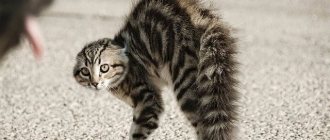The domestic cat differs from the wild one in having a more docile character. He easily makes contact with people and gladly allows himself to be taken care of. But sometimes it still shows a certain wildness in its behavior, which is expressed in the fact that the cat growls and hisses at the members of the family in which it lives. And if at first this behavior even slightly amuses some owners, then with regular and frequent manifestation of aggression in this way, any owner begins to think about its causes and possible consequences. Especially if there is a small child in the family.
Pay attention to body language
Your cat can tell you how she feels, not only by her sounds, but also by her posture. It's important to note what your cat looks like when she growls. An angry or aggressive posture will look like widened eyes, ears up, and an arched back. However, a scared cat will have normal eyes, ears and a tail underneath.
Image credit: Dimitris Vetsikas, Pixabay
While you shouldn't immediately address your growling cat, you can list a few of these different reasons why cats growl and see if they apply to your cat's situation. Then, once you know the reason, you can better calm or comfort her to potentially stop the behavior.
Why does aggression appear?
There are several common reasons: separation from the mother, severe stress, the arrival of a new cat and poor diet.
- Early separation from the mother is the most common reason. Little kittens always eat together and get used to sharing or at least being close. Therefore, when they are brought a common bowl, they already have a familiar behavior pattern. If the kitten is separated from its mother too early, it simply will not have time to learn the rules of living together.
- Stress from living on the street and in a shelter. The second risk group is street and shelter cats. During their hard life, they got used to fighting for food, eating for the future and not letting anyone near the food, even if there is a lot of it.
- The appearance of a new cat in the house can bring out dormant instincts. A domestic cat could be soft and fluffy as long as there were no competitors near its bowl.
- Improper diet can provoke aggression. For example, if you feed the cat only once a day. In nature, cats eat small meals several times a day. If this natural schedule is disrupted, the cat may sense danger and violently attack the food and not let anyone near it.
Causes
- Anger . Anger may be the most obvious reason for a cat to growl. Frustrated and angry cats may express their emotions by growling. When your cat doesn't want to be put in his crate, he may respond by growling. He may growl at you if you try to touch him or move him when he doesn't want to be moved.
- Aggression . Aggression and anger are closely related, but aggression is worth talking about separately because cats become aggressive for many reasons. The two main ways a cat may growl at you or another cat can be related to non-recognition aggression and possessive aggression (or dominance aggression). Rejection aggression occurs when a cat was previously familiar with a person or other animal, but because they have been away for a while, the cat no longer recognizes the outgoing party.
- Fear . Cats do not always growl from a defensive position. Sometimes they do this to show that they are confused or scared. This can happen when a stranger enters your home who has never been there before. A growling cat in this situation does not know what to do with the new thing, so it growls.
- Pain . If your cat growls alone and does not exhibit aggressive or fearful body language, she may be suffering from physical pain. Some cats growl when they are experiencing internal pain that you can't see, such as a urinary tract infection or aching teeth. Your cat may be communicating to you that she is in pain through this behavior.
- Moderate irritation . Sometimes cats that growl frequently are simply saying that they don't like something. Your cat may growl when the veterinarian checks teeth during an exam, trims nails, or takes his temperature. Some cats are easier to irritate than others. This will largely depend on the individual and their background.
Image Credit: Fang_Y_M, Pixabay
What does a cat express when it hisses and growls?
Communication between animals, both wild and domesticated, mainly occurs through various sounds, postures, and movements. Typically, a domestic cat experiences only positive emotions and, accordingly, behaves affectionately and purrs. When he experiences negative feelings, his behavior changes dramatically. By finding out why your pet's mood has worsened, you can easily change the situation for the better.
© shutterstock
To understand why a cat growls and hisses, you should know about the main reasons for aggression in animals. These are :
- The desire to warn a person about your bad mood or dissatisfaction. Domestic cats for the most part do not like playing with small children. Exceptions occur in cases where the parents taught the child how to play with the furry correctly. Namely, be affectionate with him, stroke him, understand that the cat is a friend and you cannot offend him. Sometimes the cat growls, warning of the danger threatening its owner. There are cases when a pet was the first to smell the gas and with its behavior saved the lives of its owners. The cat also growls loudly, sensing the approach of bad weather or an earthquake. It turns out that a cat can even help a person with its negative behavior. The main thing is to understand it in time.
- Fear is another common cause of cat aggression. An animal can be afraid of many things: from a new thing in the house to a stranger. Even an owner suddenly jumping out from around a corner can greatly frighten a pet. At the same time, a calm, generally non-aggressive cat hisses and growls in surprise. Human fear is no less common. It is relevant for a cat picked up from the street. The fear of people can last a lifetime, even if you pick up a small kitten. It is possible that he will only allow a select few to approach him, and perceive the rest as a threat. The cat will not be wild, but it will never stop behaving cautiously with new people.
- Instinctive defense of property. This category includes the cat’s area of residence, favorite resting and sleeping places, toys, food bowl and other items that the animal considers personal. It is not surprising that, in defense of his cat, he growls and hisses, thus scaring away everyone who encroaches on his personal space and things.
- Resentment or dissatisfaction. The domestic cat experiences these feelings in different situations. All furry owners are familiar with the offended look of a pet whose tail has been stepped on; this happens very often. Naturally, the cat will want to express his grievance, so he begins to hiss and sometimes growls at the offender.
- Dissatisfaction (frustration). Small kittens that are abruptly separated from their mother are most susceptible to it. They do not receive enough maternal care and milk, as a result of which they suffer emotionally. Frustration is easy to recognize. In this case, the small kitten is reluctant to make contact, but attacks the food, growls, hisses, and tries to eat everything as quickly as possible. He can also rush around the room, screaming and meowing loudly. An adult cat, in a state of dissatisfaction, becomes nervous and growls at its owner for no reason, although it perceives him as a friend.
- Manifestation of predatory instincts. Often, during the game, the cat gets so carried away that the basic instincts of his ancient predatory ancestors awaken in him. Then the cat growls, letting his wild nature take over. Just slow down the pace of the game, he will calm down and will be a cute pet again.
- Pregnancy. A cat in an interesting position needs peace, rest and maximum care. The changes occurring in her body greatly influence her behavior, and changing hormonal levels sometimes provoke frequent mood swings, increased sensitivity, and nervousness. All this leads to various manifestations of character and becomes the reason that she growls in response to certain actions of familiar and unfamiliar people.
It turns out that finding out why a cat growls and hisses will not be difficult if you take a close look at the general situation, the environment and the attitude of people towards the cat.
How to respond to a cat's growl
- Don't rush things . Pay attention to your cat's posture. Does she look like she might attack now or is she very scared? In any case, you probably shouldn't try to comfort your cat with physical touch. Growling can lead to attack and injury.
- Don't reprimand . Verbal or physical punishment of a growling cat will only add fuel to the fire. Now is not the time for reproaches. It's best to leave the cat alone for now.
- Get to the point . The best thing you can do for your anxious cat, whatever the cause, is to try to determine the cause of his anxiety. A possessive person should be praised when he is not aggressive. A cat that is afraid of another animal, object or person should be gradually exposed over a period of time and rewarded for remaining calm.
If you haven't yet figured out the cause of your cat's growling, it may be time to take her to the vet. Your veterinarian will check for potential pain points or work with you to diagnose behavioral problems to help you find a solution. I hope you soon find out why your cat is growling and put an end to it.
Posted by Jordyn Horne Jordyn Horne is a freelance writer who has covered a variety of topics including home improvement, gardening, pets, and parenting. She had moved so much over the years that she had not had time to settle down and have a pet. However, as an animal lover, she adores and cuddles any pet she comes across!
Features of kitten behavior, reasons for growling
Each stage of growing up a pet has its own characteristics, including behavior. A playful kitten, no matter how tame it is, also growls and hisses at other cats, humans, unfamiliar objects, and so on. Due to his age and lack of knowledge about the world around him, he gets scared many times more often than adult cats. In addition, like all children, kittens are very emotional, which is why they often react sharply to any irritants. Therefore, they immediately take a defensive position and begin to growl, hiss, fluffing their fur and preparing to attack or flee.
The main task of the owner of an immature cat is to introduce it to the world around it, teach it to interact with it, distinguish between safe and dangerous places, objects, and living beings. It is imperative to show the kitten that the owner is a friend, trustworthy and a leader who is responsible for him. This must be done gradually, patiently building a trusting relationship, without suppressing the pet psychologically and physically. With proper upbringing, the kitten will grow up to be an affectionate, kind, playful cat.
Imposing your authority on a kitten provokes it into greater aggression, forces it to go on the defensive, and leads to psycho-emotional stress for all participants in the upbringing process. This makes him more aggressive, often growls and hisses, in severe cases he lunges with his claws and fights back.
© shutterstock
Thus, it becomes clear that the young cat growls and hisses due to a lack of life experience, timidity, and emotionality. This goes away with age, he becomes calmer and more flexible.
Hissing as a breed trait
It has been noted that hissing may be a consequence of the breed's temperament. Thus, emotional, easily excitable cats, characterized by a quick and vivid reaction to what is happening, are prone to outbursts of emotions. These are, for example:
- Siamese;
- egyptian Mau,
- Turkish van;
- Abyssinians;
- Cornish Rex;
- orientals.
Living in isolation and lack of regular physical activity does not benefit the character of these cats, making them even more obnoxious and grouchy.
Features of other breeds. Persian and Siberian cats are very jealous of the cleanliness of their “fur coat” and can become angry if you constantly touch them with your hands. In turn, independent British people do not like hugs and cuddles, so they can hiss when treated with familiarity. And sphinxes are prone to sound outpourings and can hiss from an excess of feelings without any negative connotation.
- why do cats hiss;
- how to stop a cat from biting;
- how to understand that a cat loves you.
Unmet cat needs
Human-raised cats may complain when their needs are not met. The hissing begins, no, no, and the owner is in no hurry to fulfill some cat’s desire. For example, a cat in the kitchen is waiting for the bowl to be filled with food, but the head (at home) is in no hurry. Then the plaintive meow turns into a menacing hiss. Is it possible that the kitty curls around the owner’s legs in every possible way, waiting for the owner to stroke it another time, while he is busy with something else? Then the sweet and kind animal turns into an irritated hissing fury.
In similar situations, nothing can be done, because the cat behaves this way due to lack of good upbringing.
Hissing is inherent in this breed
In some cases, a cat hisses because it is inherent in its breed. It is possible that Siamese hiss due to the inherent behavior of this type of temperament. Some active breeds begin to hiss because the physical stress is too much for them. These are Abyssinian, Oriental, Cornish Rex and some others. Some furry breeds (Persians) cannot stand it; sometimes they wash themselves and immediately begin to pet them. And hairless cats (Egyptian breed) - they hiss every minute, because hissing is part of their conversation, and does not necessarily mean aggression.
"Hises like a snake"
Hissing is a very specific sound, eloquently indicating a strong negative reaction. A surge of irritation and negative emotions confirms the entire appearance of the animal:
- open mouth with demonstration of the entire combat set of teeth;
- burning eyes with dilated pupils;
- ears pressed to the head;
- an angry bristling mustache;
- raised wool.
Associated reactions. Depending on the degree of threat and personal temperament, the severity of the defensive reaction is not always the same, so a hissing cat may:
- At the next moment, quickly retreat, fleeing.
- Take a characteristic pose with an arched back and fluffy tail raised up, which means a more serious attitude and an attempt to intimidate the enemy.
- Apply several blows with a clawed paw, while grouping yourself and pressing your stomach to the ground, which symbolizes the intention to fight. The tail twitches nervously or whips from side to side.
Who is guilty. Dissatisfaction, fear and aggression, encrypted in hissing, can be directed both at a specific living object (a rival cat, a dog, a stranger) and “into space”, being initiated by a sudden loud sound or a flashing shadow. Regardless of the source, the cat's expression of displeasure, when further provoked, can develop into an attempt at violent self-defense and end in a harsh aggressive attack.
Signs
Typically, a cat hisses when it is afraid of other animals or people. But traditionally it is believed that in this way she shows aggression, she can even rush and attack.
When an animal makes such sounds, it becomes tense, bends its back, tail, and may press its ears. What does a hissing cat usually look like?
- His fur instantly stops being tousled , it seems that it has turned from smooth to fluffy, voluminous. Visually, the cat even looks larger at such a moment.
- When a cat is angry, his back arches . This pose is a signal that the animal can and will rush at the offender or someone who, in his opinion, poses a danger.
- The ears are flattened for a reason. They talk about distrust of those around them. It is also a kind of protection for the head from injury.
- An expressive look conveys all the emotions of a cat - courage, aggressiveness, determination. Meowing may also be heard along with the hissing, but it does not make the disheveled cat any cuter. On the contrary, the sounds complement the appearance and confirm the readiness to stand up for oneself and even rush at a person.
The owner of the animal, having studied its habits, will be able to figure out when a cat hisses because of a sense of danger, and when because of a feeling of aggression.
How to deal with this?
First of all, in the fight against xenophobia, you should not encourage the cat. If you have guests and your pet runs into a “dark corner”, you should not leave her there. Gently stroking the soft fur coat and speaking kindly, you should take it out of there and take it in your arms. And then bring it closer to the guests. Just do not hold the animal forcibly for a long time, otherwise you yourself may suffer from the tenacious claws of your pet.
Ask strangers to sit down and bring the cat into the room; you can buy a special cage or carrier bag for this to make it more convenient to familiarize it with the surroundings. You shouldn’t hold out hope that she will immediately get used to everyone and come out of her secluded place for everyone to see. If guests remain quiet and have a calm conversation, the adjustment process will go faster.
There is one more trick on how to suppress an animal’s wild fear. Develop a positive reflex to a call or knock on the door. With each such signal, the owner himself should appear on the threshold of the house and thereby show the cat that there is no danger. When she gets used to extraneous noise, you can safely invite friends.
In extreme cases, you can resort to small tricks. For example, you can try not feeding your pet for several hours, and when friends come, give them a treat and invite them to talk to the cat in a calm tone and treat it with goodies.
And as a last resort, use sedatives. But this is only as prescribed by a doctor. Otherwise, you can get your xenophobe hooked on antidepressants.
If you find an error, please highlight a piece of text and press Ctrl Enter.
The cat declared himself in charge?
In cases where a cat hisses at its owner, the character of the animal still plays the main role. Some cats are ready for any manifestation of affection from the owner and will even unquestioningly hang their heads down from a strong child’s embrace. Others are wary and dissatisfied with any light stroking, being too independent.
And yes, the cat really considers himself in charge. He thinks that they have to give him all the goodies from the refrigerator. When the cat comes to sleep on the owner’s bed, he does him a great honor. And often he prefers to come himself. And if a person puts a cat to bed, she will suddenly have completely different plans.
Cats rarely hiss at people they know, as this is a more active manifestation of aggression. They first try to communicate their displeasure by lightly biting or flicking their tail. A calm, contented cat will never wag its tail. If this happens, it means
excessive attention. It must be left alone, even after stopping stroking. In order for a cat to stop biting a person, it is enough to freeze and not move. The majestic animal will immediately accept this submission and stop attacking.










